Why does the orchid wither after transplanting and what to do?
Causes
Often, the orchid does not grow after transplantation. In this case, you should not panic, experienced flower growers have found a way to deal with such a misfortune. The problem is caused by banal improper care.
Temperature
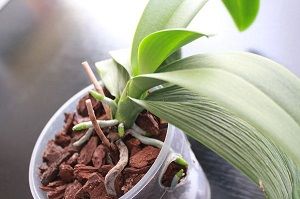 The most common cause is overheating of the root system. For beginners, this reason may seem strange, because the orchid is a great lover of heat, however, leaving the flower in a place where the direct rays of the sun fall is detrimental to the plant.
The most common cause is overheating of the root system. For beginners, this reason may seem strange, because the orchid is a great lover of heat, however, leaving the flower in a place where the direct rays of the sun fall is detrimental to the plant.
The same problem happens in the winter season, when the plant lives on the windowsill, and the strong heat from the battery also has an adverse effect. In these cases, you should not be surprised that the leaves wither, because due to heating, moisture evaporates in the root system of the orchid.
Watering
Violation of the watering regime is a strong stress for the flower. Experienced flower growers advise not to focus on a specific time and number of days. An important signal for watering is a dry substrate. If you water the flower less often or more often than it requires, the root system will either dry out or rot.
Moisture
Orchids are inhabitants of the tropics. It rains daily in such places. Therefore, when taking care at home, you should try to create living conditions close to natural. This means that after watering, the substrate must dry out without fail. Waterlogged roots will partially or completely rot.
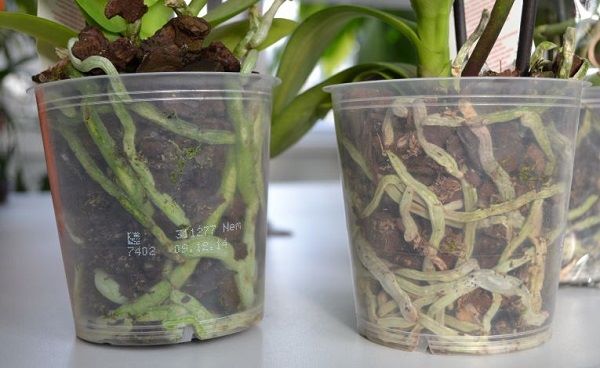
Water the orchid only after the roots are completely dry.
Diseases
Orchid leaves often wither due to diseases and various pests. For example, mites can settle on the leaves, which suck the juice out of them. Because of this, green leaves fade and wither. Ticks do not like moisture, so sufficient moisture and timely watering will be the prevention of such a disease.
Fungal infections
After transplanting an orchid, you can often see small, almost invisible formations on the leaves - fungal infections. Such tubercles can be located both on the leaves and on the stem of the flower. Most often, such an attack affects everyone's beloved phalaenopsis.
Important! The reason may be a damaged root system, overheating of the plant, lack of moisture.
Treatment and prevention are as follows:
- The orchid affected by fungi should be isolated from other plants;
- Remove infected leaves;
- Disinfect the cut sites;
- Treat the leaves with a fungicide. You can also use a fungicide for prophylaxis.
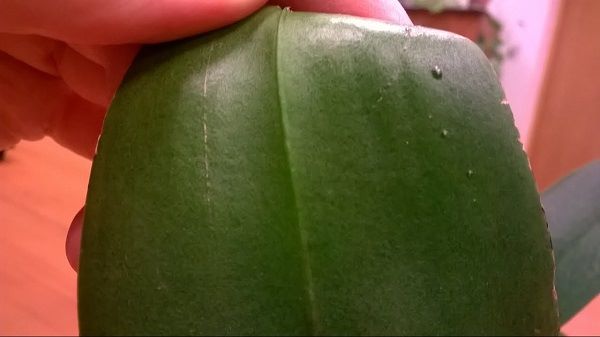
The tubercles on the leaves are myceliums.
Fertilizers
After transplantation, the root system is overly sensitive to any external influences. And first of all, on the effect of potash, phosphorus salts, which are contained in fertilizers. When using too concentrated fertilizer, the root system can both rot and dry out.
Rescue measures
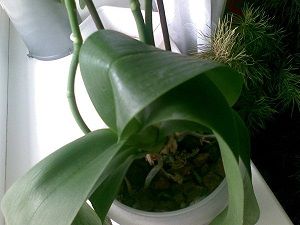 After establishing the cause of the problem, treatment and prevention should be started. Experienced growers share tips on how to save an orchid:
After establishing the cause of the problem, treatment and prevention should be started. Experienced growers share tips on how to save an orchid:
- The plant must be moved to a cooler place and the flower should be allowed to rest;
- The next step after resting is to place the plant in a container of clean water at room temperature for an hour;
- During the rehabilitation period, all fertilizers and fertilizing must be excluded;
- Spray the flower with a spray bottle to create the desired moisture level;
- Dry the leaves with a cotton cloth, as it quickly absorbs moisture;
- The restoration is completed by moving the flower to a bright room, where direct sunlight does not fall. Now the foliage will definitely come to life and restore its natural green color.
Symptoms and causes of the disease
An accurate knowledge of the causes of a flower's disease will help you understand how to save an orchid and provide it with proper care.
Orchid diseases:
- Flowering problems. There are three main ones:
- does not bloom,
- buds can wither or rot,
-
dark spots appear on the flowers.
- Various rot:
- Brown bacterial. In this case, the leaves begin to rot.
- Rotten roots. In most cases, a transplant will be required.
- Leaves can rot and become covered with a gray or black coating - this indicates the presence of fungi.
- Fusarium rot - the leaves begin to turn yellow.
- Leaf diseases:
- Anthracnose. The leaves are attacked by a fungus, and they are covered with small black spots. This happens due to stagnation of water in the axils of the leaf.
- Bacterial spot. At first, the leaves turn yellow, then they can rot, then they soften, crack, dry out and fall off.
- Leaf deformation, lost turgor.
- Leaf burn. It often occurs in the summer. If you do not put the orchid in the shade in time, the leaves will die very quickly, forming holes at the burn sites.
- Powdery mildew. The plant becomes covered with a white bloom and soon dies if no action is taken.
- Viral diseases. They do not manifest themselves for a long time, they cannot be treated, the flower will have to be destroyed.
Important! As soon as a virus is detected in an orchid, it should be immediately removed from other plants and destroyed. If watering is common in one container, then other flowers are likely to be infected.
In this case, they must be treated with antibiotics.
The causes of diseases can be:
- A virus or fungus can be brought in with tools.
- Overheat.
- Excessive or insufficient watering.
- Wrong amount of top dressing.
- Parasites, insects in the soil.
- The substrate has not changed for a long time.
- Bad light.
How to revive an orchid without roots
There are two ways to grow roots: into the bark with moss and into the water. First you need to remove all the dead roots, in the end, only the neck with leaves will remain. The place from which the roots used to grow must be wiped with succinic acid. To do this, you can moisten a cotton pad in the solution and walk over the leaves and along the neck.
- way. After treatment with succinic acid, place the plant in moist moss with bark. This substrate must be kept moist, that is, sprayed daily or every other day. Place the pot with the plant on the window, but not in direct sunlight. The favorable air temperature for resuscitation of an orchid without roots is 24-25 degrees.
- way. Phalaenopsis treated with succinic acid should be placed above the water in such a position that the remaining neck does not touch the water; there should be two centimeters from the stem to the water. The resulting structure, as in the previous method, must be placed on the window.
The first roots will appear after a period of 3 weeks to 6 months. When they grow up to 3-4 cm, the plant can already be transplanted into an orchid substrate and watered like a normal healthy plant.
The orchid dies
External manifestations
The main reason for the possible death of an orchid is damage to the root system caused by improper care or disease.
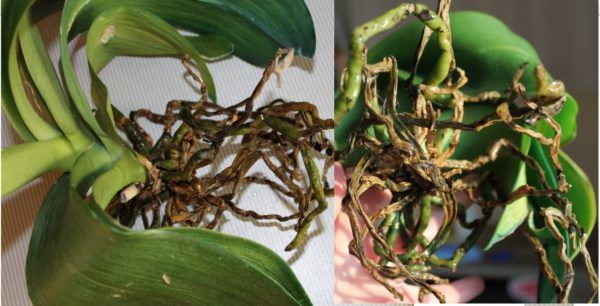
Most often, orchids die due to decay of the root system.
Signs that are common and require urgent intervention are:
- Withering of the main leaf mass;
- Wrinkling of leaf plates and their yellowing;
- Drying of leaves along the entire length of the stem;
- Instability of the plant in the container;
- Loss of more than 70% of roots.
How to determine in the early stages?
The first sign by which one can judge about possible unpleasant consequences is a change in the structure, color and state of the leaves.
The appearance of parasitic pests, foci of rot at the junction of the leaf and stem - all this must be eliminated in the early stages, without waiting for development. Discharge of buds and flowers can also be caused by improper care and be a harbinger of trouble.
The rescue
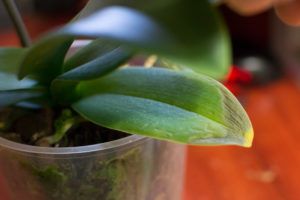 What if the orchid dies? A rotted, frozen, drying or already dried orchid is an unpleasant sight. But if at least a piece of living tissue remains on the trunk of a plant, it can be reanimated, returning to a normal, full life.
What if the orchid dies? A rotted, frozen, drying or already dried orchid is an unpleasant sight. But if at least a piece of living tissue remains on the trunk of a plant, it can be reanimated, returning to a normal, full life.
Unfortunately, not every florist takes care of his pet, but prefers to buy a new one. By this, he not only does not gain experience, but also does not try to find out his mistakes when growing exotic.
There are risks in which it is almost impossible to save the orchus. If the plant is weakened and has undergone fusarium wilting with damage to most of the trunk, then the chance of recovery is no more than 5%.
Important! The big risk of not saving the plant is the presence of a viral disease (infection).
There is always a risk that resuscitation will not help. Much depends:
- From the state of the plant;
- From neglect of the problem;
- And methods of salvation.
But you should always try to bring the plant back to life.
Home orchids
Orchids that are very tenacious in the wild, placed on a windowsill, can suddenly dry out and die due to non-observance of the essential conditions for their cultivation. They can hardly tolerate the dry and dusty air of apartments. Plants often suffer from drafts, but the stagnant air of enclosed spaces is even more detrimental to them.
A metered amount of solar insolation is useful for a flower, and excessive light can burn the leaves. Plants can hardly tolerate low-quality tap water, which is better replaced with rainwater. Much depends on the timely and high-quality watering of the plants.
Advice! A distinctive feature of orchids is the participation of their roots in photosynthesis. Therefore, it is better to keep them in transparent pots with breathing holes.
To maintain the well-being of the flower, you must observe:
- The rules for his transplant;
- Do not overfill;
-
And do not rearrange to a new place unnecessarily.
If the orchid begins to dry up, there are reasons for this. They will be discussed. If the rules of home care are not followed, the orchid dies.
How to reanimate a flower at home?
Before rescuing an orchid, the damage should be assessed. For this:
carefully remove the plant from the container;
we remove the remnants of the substrate from the root system;
wash the rhizome with warm water;
we spread it on a towel, let it dry in the open air at room temperature;
all instruments for further work are sterilized; for this they can be boiled or treated with a peroxide solution;
we cut off all the dead sections of the root system;
the places of the cuts are treated with cinnamon powder, or coal powder (obtained from an activated carbon tablet).
Important! You do not need to remove yellowed leaves if the plant does not have roots - this is the only source of its nutrition. Also do not cut dried pseudobulbs
Resuscitation actions will depend on the condition of the flower and which parts of it remain healthy.
Resuscitation from sleeping kidneys, if no other materials are available
An orchid without roots and leaves can be tried to grow again if the peduncle is preserved. From his sleeping buds, you can grow a baby.
This is done in two ways:
- place the cut peduncle in a container with water;
- divide the peduncle into parts with a dormant bud of two to three centimeters, put them on a damp substrate (sphagnum moss).
We offer to watching a video abouthow to reanimate an already seemingly dead orchid:
If a plant with one strong leaf or several lethargic, but no roots
When a flower has lost its root system, but at least one leaf, or a few leaves, albeit sluggish, has survived, its salvation has a confident chance. For rooting, the orchid is placed:
- into a closed system;
- in a greenhouse on a wet substrate;
- fixed in a vessel over water.
New roots should grow from the bottom of the stem. Once this has happened, the vegetative part will begin to develop.
We offer you to watch a video on how to build up the root system of an orchid in stones:
If the entire upper covering part has fallen off
If the flower has preserved its root system, but leaves are completely or partially lost, it is advised to plant it in fresh soil and continue with normal care. Watering should be replaced by spraying the substrate. After the root system grows, new leaves are formed from the point of growth.
Is it possible to recover without a growth point?
If only the lower part of the stem with the root collar and a small part of the rhizome remain from the flower, it is placed in fresh soil. It should be looked after as usual. Spraying is excluded, watering is significantly reduced. In this mode, lateral shoots appear from dormant buds on the surface of the stem. These are orchid babies.
Resuscitation in greenhouse conditions creates a comfortable environment for the orchid, similar to its usual habitat. In the greenhouse, the temperature is constantly maintained at + 24-28 ° C, the humidity level should be 80-90%. Expanded clay, moss or a suitable substrate are placed on the bottom. The container must be ventilated, in autumn and winter, 10-12 hour daylight hours are provided.
Advice. A greenhouse can be made from an empty aquarium, a large plastic bottle, a bag, or an inverted container.
We offer you to watch a video on how to restore an orchid without a growth point:


